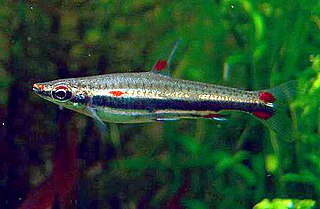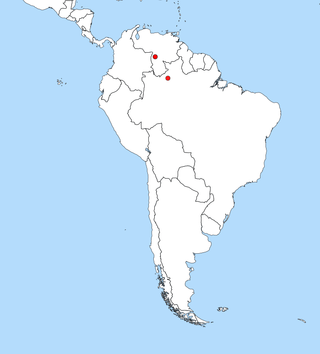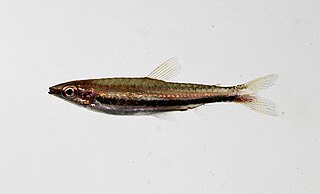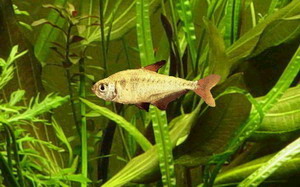
Nannostomus,, is a genus of fish belonging to the characin family Lebiasinidae. All of the species in this genus are known as pencil fish, a popular name that was first only applied to two species in the 1920s, Nannostomus unifasciatus and Nannostomus eques. By the late 1950s, the term would come to be applied to all members of the genus. Several species have become popular aquarium fish due to their attractive coloration, unique shape, and interesting demeanor.

Nannostomus trifasciatus,, commonly known as the three-lined or three-stripe pencilfish, is a freshwater species of fish belonging to the characin family Lebiasinidae. They are popular in the aquarium trade due to their small size, beautiful color pattern, and relative hardiness.
Nannostomus harrisoni,, is a species of pencil fish. Native to The Guianas, the species displays a single horizontal stripe of intense black, and blood red adornments on its fins. N. harrisoni is often confused with Nannostomus unifasciatus, another long, slender, single-striped species with similar profile and coloration, but N. harrisoni swims in a horizontal posture, as opposed to the snout-up oblique posture of N.unifasciatus, and the bright red adornments on the ventral fins of N. harrisoni are absent in N. unifasciatus. Though the recently described species N. grandis has been dubbed the largest member of the genus, adults of N. harrisoni commonly grow to a length of 70 mm, making it in fact the largest species of pencil fish described to date. It is commonly known as Harrison's pencilfish.

The chameleon goby is a species of ray-finned fish native to marine and brackish waters along the coasts of eastern Asia. It has also spread to other parts of the world where it is found in waters with varying degrees of salinity.
Derhamia hoffmannorum is a species of freshwater fish endemic to Guyana, where it is found in the Mazaruni River. It is the only species in its genus. It is found in fresh water at pelagic depths in a tropical climate. The average length of an unsexed male is about 6.1 cm (2.4 in). It has an elongated body with large eyes. It is a timid species compared to other similar species such as the various pencilfish. They live near the surface of water and are known to hide whenever possible, usually under floating objects. This species only eats what can be found at the surface, as well. D. hoffmannorum will not seek food that sinks to the bottom.

Nannostomus anduzei is a freshwater species of fish belonging to the genus Nannostomus in the characin family Lebiasinidae. It is native to Venezuela and northern Brazil, particularly the upper Orinoco and Rio Ererê, a tributary of the Rio Negro. The adults grow to a maximum length of only 16 mm, making them one of the smallest pencilfish. Other common names include miniature pencilfish, miniature nannostomus, and Anduzi's nannostomus.

Nannostomus beckfordi,, commonly known as the golden pencil fish or Beckford's pencil fish, is a freshwater species of fish belonging to the characin family Lebiasinidae. It occurs widely and commonly in swamps and slow-moving waters in Brazil, Guyana, French Guiana, and Suriname.
Nannostomus britskii, ,commonly known as the spotstripe pencilfish, is a freshwater species of fish belonging to the family Lebiasinidae of characins. They were first described in 1978 by Stanley H. Weitzman along with two other new species, from a collection of specimens preserved in the São Paulo museum. They have been recorded from only two localities, both in Brazil. No live specimens had been seen, collected, or exported for the aquarium trade until very recently.
Nannostomus digrammus,, commonly known as the twostripe pencilfish, is a freshwater species of fish belonging to the characin family Lebiasinidae. They were first described in 1913 by Henry Weed Fowler and are fairly typical of members of this genus being small, elongated fish with prominent horizontal stripes, in this case limited to two dominant stripes, usually maroon in color. They are recorded as native to Brazil and Guyana, where they occur fairly widely, but are seen only occasionally in the aquarium trade.

Nannostomus eques,, commonly known as the diptail pencilfish or brown pencilfish, is a freshwater species of fish belonging to the characin family Lebiasinidae. It was first described in 1876 by Franz Steindachner making it one of the first members of the genus to be discovered and described. It is fairly typical of members of this genus being a small, elongated fish with prominent horizontal stripes. It occurs quite widely in South America, having been recorded in Brazil, Peru, Colombia, and Guyana. It is also quite commonly met with in the aquarium trade where its habit of swimming and posturing at a 'snout-up' angle—one of two Nannostomus species to do so, the other being Nannostomus unifasciatus—makes it a popular choice.

Nannostomus espei,, commonly known as Espe's pencilfish or barred pencilfish, is a freshwater species of fish belonging to the characin family Lebiasinidae. It was first described in 1956 by Herman Meinken from the Mazaruni River system in Guyana and to date this is its only known location. It is notable amongst the genus in that the dominant body pattern consists of five broad, comma-like patches instead of the more normal horizontal stripes seen in the rest of the genus. This pattern of patches is assumed by other species at night, but only N. espei displays the pattern permanently and in daylight.

Nannostomus limatus,, commonly known as the elegant pencilfish, is a freshwater species of fish belonging to the characin family Lebiasinidae. They were first described in 1978 by Stanley H. Weitzman along with two other new species, from a collection of specimens preserved in the São Paulo museum. Only rarely imported and kept by aquarists, they have been recorded from the Amazonian region of Brazil, specifically near Santarém.

Nannostomus marginatus,, commonly known as the dwarf pencilfish, is a freshwater species of fish belonging to the genus Nannostomus in the characin family Lebiasinidae. They were first described in 1909 by C. H. Eigenmann and are typical of members of this genus being small, elongated fish with prominent horizontal stripes. The most notable feature of N. marginatus is its size, it being one of the smallest members of the genus, only reaching a maximum size of 35 mm. They occur widely on the South American continent having been recorded in Brazil, Guyana, Colombia, Suriname, and Peru, and have been a popular aquarium species since their introduction to aquarists in the early twentieth century.

Nannostomus marilynae,, commonly known as Marilyn's or greenstripe pencilfish, is a freshwater species of fish belonging to the characin family Lebiasinidae. They have been recorded from the Rio Negro and Rio Orinoco regions of Brazil, Venezuela, and Colombia.

Nannostomus minimus,, commonly known as the least pencilfish, is a freshwater species of fish belonging to the characin family Lebiasinidae. It is restricted to Guyana, where it has been reported from the Potaro and Mazaruni Rivers.

Nannostomus mortenthaleri, commonly known as the coral red pencilfish, is a freshwater species of fish belonging to the characin family Lebiasinidae. It is one of the most colourful of the genus, being suffused with a bright coral red colouration over its entire body and fins, in striking contrast to its horizontal jet black stripes. It was originally described as a subspecies of Nannostomus marginatus, but it is now recognised as a species in its own right. Mature males have a thickened anal fin. Maximum length is 29mm.
N. marginatus may refer to:

Nannostomus unifasciatus,, commonly known as the one-lined pencilfish, is a freshwater species of fish belonging to the genus Nannostomus in the characin family Lebiasinidae. They are popular in the aquarium trade due to their small size, beautiful color pattern, unique swimming posture and relative hardiness. With its long, pencil-shaped profile, its single jet black stripe reminiscent of the graphite core of a pencil, and its eraser-colored caudal fin, this is the species for which the popular name, 'pencilfish', was first coined in the 1920s, later to be applied to all the species of the genus Nannostomus.

Hyphessobrycon bifasciatus, or Yellow tetra, is a species of fish in the family characidae.

Copella arnoldi, commonly known as the splash tetra or the splashing tetra, is a species of tropical freshwater fish belonging to the family Lebiasinidae. It is native to South America.















